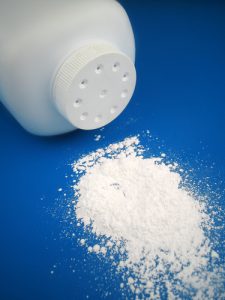5 Facts about the Link between Talcum Powder & Ovarian Cancer
October 25, 2018
5 Facts about the Link between Talcum Powder & Ovarian Cancer
For decades, talcum powder (talc) has been used in all sorts of consumer products and industrial applications. Despite its effectiveness at absorbing moisture, talc has been linked to an elevated risk of ovarian cancer.
Understanding the nature of this link can be crucial to determining whether negligence may have contributed to a case of ovarian cancer – and, if so, discovering the options for:
- Holding the negligent party (or parties) accountable
- Pursuing the financial recoveries victims need and deserve.
Shedding more light on this, the following shares a handful of important, scientifically-backed facts regarding the connections between talcum powder and ovarian cancer.
If, however, you currently need legal advice specific to your situation and possible talcum powder claim, don’t hesitate to contact the talcum powder lawyers at the Amaro Law Firm. We are ready to give you critical insights about your legal options.
Have You or a Loved One Been Diagnosed with
Ovarian Cancer following Exposure to Talcum Powder?
Call (713) 352-7975 or Email Our Firm
for a FREE, Confidential, No Obligations Consultation
Discover more about your potential claim and how to proceed in a free consultation. The Amaro Law Firm represents people from across the U.S. talcum powder claims, and we offer free virtual and mobile consultations to anyone who is unable visit our offices.
While we know that compensation can never reverse an ovarian cancer diagnosis, we also know that the recoveries from these claims can be pivotal to restoring lives.
What You MUST Know about Talcum Powder & Ovarian Cancer: 5 Essential Facts
- The link between talcum powder and ovarian cancer has been known since the early 1970s – In March 1971, a groundbreaking study1 reported finding talc particles in tissues from ovarian and cervical tumors. According to the findings, about 3 in every 4 tissue samples analyzed had “talc particles deeply embedded” within them, seeming to suggest a connection between perineal (genital) use of talc powder, a movement of talc particles to the ovarian and cervical tissues, and a link between use of talc and ovarian cancer.
- Since the 1970s, dozens of studies have confirmed the link between talc and ovarian cancer – While there have also been inconclusive studies and studies disputing the link, more than 20 case-control studies have supported the connection between use of talc and a higher risk of ovarian cancer. Attempting to quantify this risk, one study reported finding that use of talc could raise the risk of developing ovarian cancer by approximately 30 percent.
- The U.S. Food and Drug Administration (FDA) is currently conducting its own talc studies – Currently, the FDA is investigating the potential risks associated with talcum powder. Their goal is to “fill some of the existing data gaps” and provide “experimental models for further mechanistic studies.” 2 Although it will still be months, if not years, before the FDA’s findings are available, the hope is that this study will yield more definitive data regarding the link between talc powder and ovarian cancer.
- The World Health Organization (WHO) has recognized the possibility that talc may be carcinogenic – In the 1990s, the International Agency for Research on Cancer (IARC), a division of the WHO, set forth official guidance on talc’s cancer risks. Specifically, the IARC classified talc containing asbestos as “carcinogenic to humans” and genital use of talc-based body powers as “possibly carcinogenic to humans.”3
- Although Johnson & Johnson (J&J) has strongly denied the link between talcum powder and ovarian cancer, juries have believed the link exists and have granted huge awards to victims/plaintiffs – In fact, in July 2018, a St. Louis jury awarded 22 plaintiffs in a talc case $4.6 billion, sending a very strong message to J&J. In May 2018, another jury issued a plaintiff $110.4 million for her talc case. Additionally, in May and October 2016, other juries awarded plaintiffs in talc and ovarian cancer cases $55 million and $72 million (respectively). While J&J has vowed to appeal these massive verdicts, it’s clear that juries across the U.S. believe that exposure to talcum powder can play a role in causing ovarian cancer and that the makers of talc products, like J&J, must pay when their products play a role in causing serious injuries.
If you or a loved one has been diagnosed with ovarian cancer after exposure to or use of talcum powder, the experienced attorneys at the Amaro Law Firm are ready to discuss your potential claim and provide you with helpful legal advice – and exceptional representation – moving forward.
Find Out More about a Potential Talc Claim: Contact a Houston Personal Injury & Product Liability Attorney at the Amaro Law Firm
A Houston personal injury & product liability attorney at the Amaro Law Firm can help you pursue all available legal remedies if you or a loved one has developed ovarian cancer after use of talcum powder.
Call (713) 352-7975 or email our firm for your FREE consultation and essential information regarding your potential claim. We can help you navigate the road ahead.
The Amaro Law Firm’s record of extraordinary representation and success in dangerous product cases has earned us glowing testimonials from former clients and 5-star ratings on Google and Facebook.
________________________________________________________________________________
1: 1971 Talc & Ovarian Cancer Study
2: FDA on Talc & Current FDA Talc Study
3: IARC on Talc
